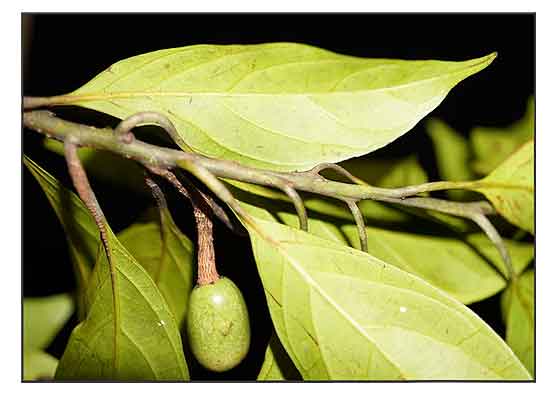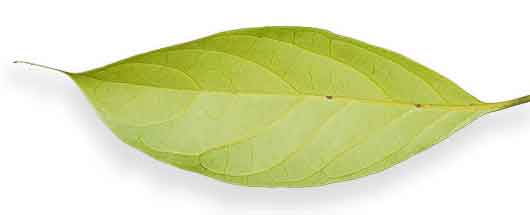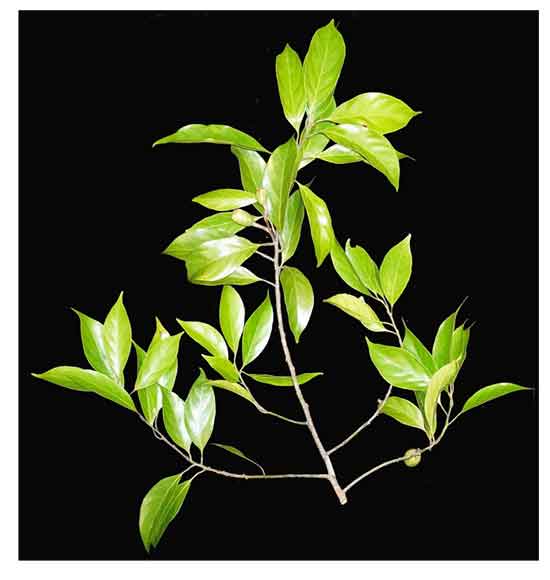
Family • Lauraceae
Malabunga
Nothaphoebe umbelliflora (Blume) Blume
COMMON FALSE LAUREL / BONG TREE
| Scientific names | Common names |
| Aiouea malabonga Blanco      | Malabunga (Tagalog) |
| Alseodaphne malabonga (Blanco) Kosterm.      | Bong tree (Engl.) |
| Alseodaphne umbelliflora (Blume) Hook.f.      | Common false laurel (Engl.) |
| Dehaasia nitida Meisn.      | White gemor (Engl.) |
| Euphoebe umbelliflora (Blume) Meisn.      | Yang bong tree (Engl.) |
| Mastixia cuneata Blume      | |
| Nothaphoebe malabonga (Blanco) Merr.      | |
| Nothaphoebe umbelliflora (Blume) Blume      | |
| Ocotea umbelliflora Blume      | |
| Phoebe umbelliflora (Blume) Nees      | |
| Nothaphoebe umbellifora is an accepted species. KEW: Plants of the World Online | |
| Other vernacular names |
| BORNEO: Marsihung tanduk, Medang. |
| THAILAND: Yang bong, Gemor. |
| VIETNAM: Khao mo vang, Boi loi vang, Gia su tan, Su nguy. |
| OTHERS: Medang losa. |
March 2024
![]()
 |
| Â Â Â Â Â Â Â Â Â Â Â Â Â Â Â Â Â Â Â Â Â Â Â Â Â PHOTOS / ILLUSTRATIONS |
| IMAGE SOURCE: Nothaphoebe umbelliflora: Marsihung tanduk / Leaves and fruit / Reuben C J Lim / CC BY NC-SA 2.0 DEED / Click on image or link to go to source page / flickr |
| OTHER IMAGE SOURCE: Nothaphoebe umbelliflora: Marsihung tanduk / LeaF / Reuben C J Lim / CC BY NC-SA 2.0 DEED / Image modified / Click on image or link to go to source page / flickr |
| OTHER IMAGE SOURCE: Nothaphoebe umbelliflora: Marsihung tanduk / Twigs and leaves / Reuben C J Lim / CC BY NC-SA 2.0 DEED / Image modified / Click on image or link to go to source page / flickr |
Additional
Sources and Suggested Readings |
• |
DOI: It is not uncommon for links on studies/sources to change. Copying and pasting the information on the search window or using the DOI (if available) will often redirect to the new link page. (Citing and Using a (DOI) Digital Object Identifier) |
| Â Â Â Â Â Â Â Â Â Â Â Â Â Â Â Â Â Â Â Â Â Â Â Â Â Â Â Â Â Â List of Understudied Philippine Medicinal Plants |
| Â Â Â Â Â Â Â Â Â Â Â Â Â Â Â Â Â Â Â Â Â New plant names needed The compilation now numbers over 1,300 medicinal plants. While I believe there are hundreds more that can be added to the collection, they are becoming more difficult to find. If you have a plant to suggest for inclusion, native or introduced, please email the info: scientific name (most helpful), local plant name (if known), any known folkloric medicinal use, and, if possible, a photo. Your help will be greatly appreciated. |
• |
 |

 Gen info
Gen info

